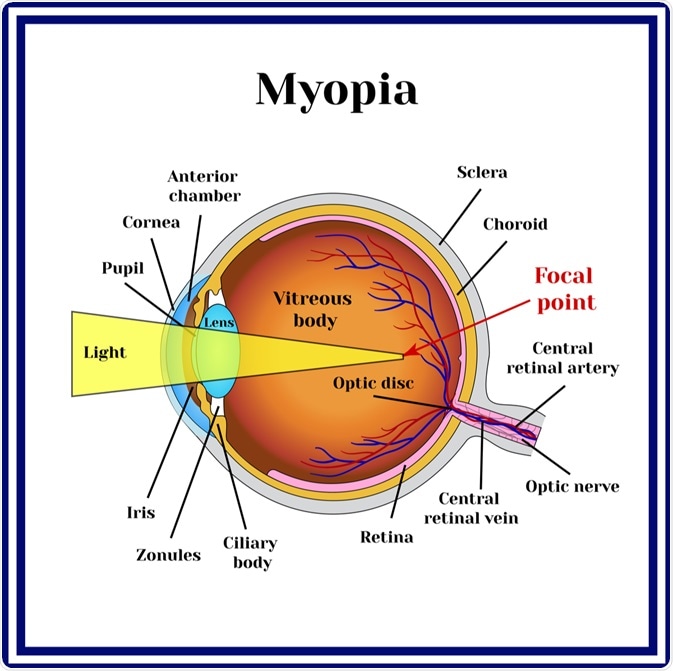Myopia (shortsightedness) is the most common ocular abnormality with growing prevalence worldwide and in a progressive nature in children, which have both contributed to a recent surge in interest. Experimental and observational studies that have revealed the complex nature of human refractive variation have one ultimate goal – to avoid any onset of myopia.
Various environmental and genetic factors have been shown to control eye growth and influence myopia development. Nevertheless, investigations into the association of these two factors in controlling refractive development have been hampered by the lack of a genetically modifiable animal model. However, technological advances in recent years have made the assessment of refractive state and ocular biometry in the mouse model possible.

Image Credit: Chanintorn.v / Shutterstock
Research trends
In recent years a lot of efforts are put into researching the balance between central and peripheral hyperopic (growth-promoting) and myopic (growth-inhibiting) defocus in different natural environments, hoping that it will lead to interventions or treatment modalities for myopia. Studies on animals (namely mouse models) have shown that peripheral defocus is able to influence the rate of axial eye growth.
The pathways implicated in eye growth control and myopia development in avian animal models have been partially characterized, but at this stage, it is not clear that these pathways can be transferred to eye growth control in humans. Recent studies have shown that eye elongation and myopia progression seem to decrease in periods with longer days and to increase in periods with shorter days, thus children should be encouraged to spend more time outside.
There is a widely held perception in the scientific community that myopes generally tend to have superior intelligence quotients. In order to quantify this relationship, studies have been commissioned to determine the weight of myopia in terms of its influence on intelligence tests. Although there is some evidence contributing to myopia and high intelligence hypothesis, more trials are needed in order to establish the veracity of this association.

Diagram of myopic eye. Image Credit: Mrs_Bazilio / Shutterstock
Candidate gene studies
Candidate genes for myopia are genes that encode for a protein product that can allegedly influence susceptibility, severity, or progression of myopia on an individual level. Altered susceptibility to myopia in humans appears to be highly polygenic with many candidate genes implicated, although subsequent studies are needed to replicate the results.
The list of hypothesized candidate genes for nearsightedness is mostly based on our current understanding of the pathophysiology of syndromic myopia. The results for many of the candidate myopia genes are promising with potential biological plausibility, but most of them are performed on single candidates and are not conclusive yet.
Gene encoding for transforming growth factor-β (TGF- β) plays a crucial role in the process of scleral remodeling, and significant reductions of this product have been found in myopic eyes. Furthermore, both PAX 6 and SOX2, two so-called “master control genes” that play a major role in eye development and growth, have been implicated in myopia pathogenesis – possibly due to genetic variation in an upstream promoter or regulator.
An association between common myopia and polymorphisms in three genes coding for matrix metalloproteinases (enzymes that degrade matrix proteins and modulate scleral extensibility) has recently been reported. Hepatocyte Growth Factor (HGF) is still a widely studied candidate gene for myopia, as its genetic variants are associated with high myopia in family-based association studies.
Another candidate gene is the collagen type-1 alpha-1 gene (COL1A1), which is an extracellular matrix gene expressed in the scleral wall in patients with high myopia (but also in experimental myopia). A case-control study in Japan revealed an association of high myopia with two single nucleotide polymorphisms for this gene, although a follow-up study revealed no significant link, inferring a weaker genetic risk associated with this gene than originally thought.
Several new loci on different chromosomes have recently been identified and linked to myopia. A novel autosomal dominant high myopia locus on chromosome 5p15.33-p15.2 was found in one of the first genome-wide scans in an Asian population. Linkage of myopia to chromosome 20 was also established, while the existence of a myopia quantitative trait locus to chromosome 11 has been backed up with further studies.
The selection of candidate genes will be facilitated immensely if some of the potentially important genes could be first linked to myopia via a genome-wide screen. As our understanding of the molecular mechanisms underlying the susceptibility and progression of this condition is still limited, novel and crucial genes are yet to be discovered.
Further Reading
Last Updated: Feb 10, 2021